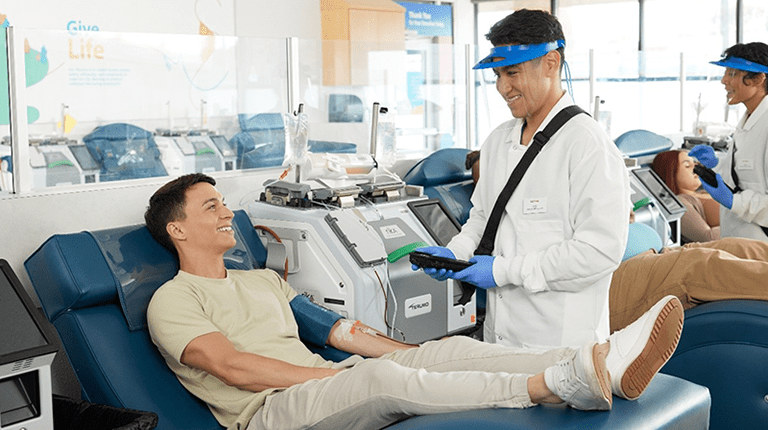The Power of Plasma
CSL’s Commitment to Rare Diseases, Emergency Medicine and Women’s Health
CSL is a global biotechnology leader that develops and delivers innovative medicines that help save lives, support public health and help improve the quality of life for people with life-threatening medical conditions. We are guided by our commitment to making a meaningful and lasting difference in the lives of patients. CSL operates one of the world’s largest plasma donation networks, with more than 300 centers in the United States.
Donated plasma is used to help produce plasma-derived therapies which have several important medical purposes. These therapies are commonly used in the treatment of certain rare and chronic diseases such as bleeding disorders, immune deficiencies, hereditary angioedema, respiratory illnesses, and neurological disorders. These therapies are also critical for emergency departments, operating rooms and burn units to help treat conditions such as trauma, burns, and as part of the treatment of shock. In addition, certain plasma-derived therapies are vital in maternal-fetal medicine including the prevention of conditions like hemolytic diseases in newborns which can lead to severe complications if left untreated.

Plasma and Rare Diseases
Plasma-derived therapies (PDTs) are used in the treatment of a number of rare medical conditions. For example, individuals with certain immune deficiency may lack specific plasma proteins or have proteins that do not function properly which can contribute to serious, and sometimes life-threatening health conditions. Plasma-derived therapies (PDTs) are developed using functional plasma proteins collected from eligible donors and manufactured through an innovative, controlled, and regulated process. In many cases, plasma-derived therapies are considered among the most effective treatment options currently available for certain rare diseases.
In the last 50 years, advances in plasma-derived therapies have been associated with significantly improved survival rates for individuals with common variable immune deficiency (CVID), one of the more frequently diagnosed primary immune deficiencies. According to a 2008 study, the 12-year survival rate of patients with CVID was 30 percent in 19721. By 2008, that rate increased to 91 percent reflecting the impact of advances in diagnosis, treatment, and care including the use of plasma-derived therapies.
Treating rare and serious conditions with plasma-derived therapies requires a significant number of plasma donations to treat one patient for a year.
- More than 1,200 plasma donations are needed to treat one person with hemophilia for a one-year supply of medicine.
- More than 130 plasma donations are needed to treat one person with a primary immune deficiency for one-year supply of medicine.2
These are just a few reasons why plasma donations and a consistent supply of plasma are critical.
Plasma and Emergency Medicine
PDTs are used every day to treat patients in a variety of hospital settings, including emergency rooms, operating rooms, and intensive care units.
In surgery, PDTs are often used to prevent or control bleeding due to several different causes. For example, patients taking blood thinners may be at increased risk of bleeding during or after surgery. In such instances, certain plasma-derived therapies, such as a prothrombin complex concentrates (PCCs) may be used to help prevent or reduce the risk of major bleeding in these situations.3
Plasma is commonly used to help treat trauma patients, who have suffered a traumatic injury, are in shock or suffered severe burns4,5. Albumin, one of the more common PDTs, is used to treat low blood volume, and has also shown a potential survival benefit when used as a resuscitative fluid for those patients who have sepsis6.

Plasma and Women’s Health
Another key and increasing area where PDTs are used to help individuals is in women’s, particularly in the context of maternal care. The most common bleeding disorder is von Willebrand disease (VWD) which affects approximately 1% of the global population (approximately 81 million individuals)7.
Women who have VWD often experience heavy or prolonged menstrual bleeding that can impact a woman’s physical, social, emotional and material quality of life. Plasma-derived therapies are often used to help treat VWD and manage heavy menstrual bleeding8.
Pregnant women with VWD are at an increased risk for serious bleeding during and after delivery. PDTs help new mothers have a safe pregnancy, deliver a healthy child and manage post-partum bleeding9.
In the case of Rh incompatibility (when the pregnant mother is Rh-negative, and the fetus/newborn is Rh-positive) the mother is exposed to the blood of the fetus during pregnancy, labor or birth. When this occurs, the mother’s immune system is prompted to develop antibodies against Rh positive cells10. This immune response can lead to hemolytic disease of the fetus and newborn (HDN), a serious condition that can lead to brain damage if left untreated. In countries where PDTs are widely available, HDN has been nearly eradicated through education and availability of these therapies to help prevent these complications.
Donated plasma from donors, who are rewarded for their commitment, is critical in supporting the treatment of rare diseases, emergency medicine, and women’s health. CSL is committed to working every day to help improve the lives of our patients who rely on plasma-derived therapies. For more information or to find one of plasma donation centers near you, please visit us at CSL Plasma.
1 Chapel, H, Lucas, M, Lee, M, et al. Common variable immunodeficiency disorders: division into distinct clinical phenotypes. Blood. 2008;112(2):277-286. https://doi.org/10.1182/blood-2007-11-124545.
2 Source: Plasma Protein Therapeutics Association
3 Cleveland Clinic. Warfarin (Coumadin): What it is, Uses & Side Effects. Published June 9, 2023. Accessed September 19, 2023. https://my.clevelandclinic.org/health/drugs/16182-warfarin-a-blood-thinning-drug-what-you-need-to-know-.
4 Mayo Clinic. Burns - Symptoms and Causes. Published August 13, 2022. Accessed September 19, 2023. https://www.mayoclinic.org/diseases-conditions/burns/symptoms-causes/syc-20370539.
5 U.S. Food & Drug Administration. Albuminex. Published September 14, 2023. Accessed September 19, 2023. https://www.fda.gov/vaccines-blood-biologics/approved-blood-products/albuminex.
6 Rhodes, A, Evans, LE, Alhazzani, W, et al. Surviving Sepsis Campaign: International Guidelines for Management of Sepsis and Septic Shock: 2016. Intensive Care Medicine. 2017; 43:304–377. https://doi.org/10.1007/s00134-017-4683-6.
7 CSL. von Willebrand Disease. N.D. Accessed September 8, 2023. https://www.csl.com/patients-public-health/rare-and-serious-diseases/hereditary-bleeding-disorders/von-willebrand-disease.
8 Committee on Adolescent Health Care. Committee Opinion: Screening and Management of Bleeding Disorders in Adolescents with Heavy Menstrual Bleeding (Number 785). American College of Obstetrics and Gynecology; 2019. https://www.acog.org/clinical/clinical-guidance/committee-opinion/articles/2019/09/screening-and-management-of-bleeding-disorders-in-adolescents-with-heavy-menstrual-bleeding.
9 James, P, Hames, AH. Von Willebrand disease (VWD): Gynecologic and obstetric considerations. UpToDate; 2023. https://www.uptodate.com/contents/von-willebrand-disease-vwd-gynecologic-and-obstetric-considerations.
10 American College of Obstetricians and Gynecologists. The Rh Factor: How It Can Affect Your Pregnancy. N.D. Accessed January 10, 2024. https://www.acog.org/womens-health/faqs/the-rh-factor-how-it-can-affect-your-pregnancy.


